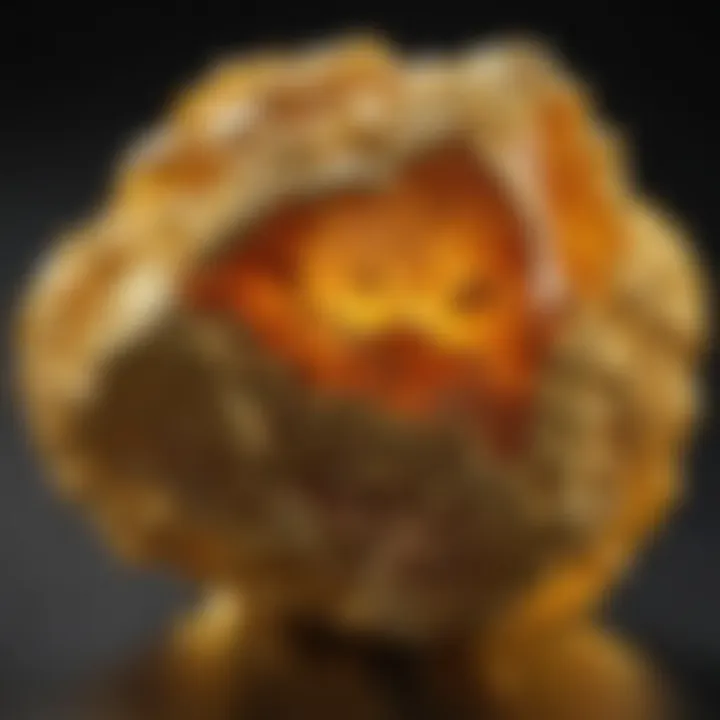Exploring Gold: Its Essence, Value, and Legacy


Intro
Gold has long captured the imagination of humankind, serving as both a coveted adornment and a symbol of wealth. Its shine has fascinated many, from ancient civilizations to modern society. As we embark on this detailed exploration, we will touch upon the rich facets that gold embodies, shedding light on its historical, cultural, and economic significance.
Understanding gold is not merely about its value on the market but also how it has shaped various cultures and what it continues to represent today.
Gemstone Overview
Gold, often referred to in its geological context, is primarily recognized for its unique properties that distinguish it from other minerals. Its luster, malleability, and resistance to tarnish make it not just precious, but also practical for a variety of uses.
Definition and Characteristics
Gold is a chemical element with the symbol Au, derived from the Latin word 'aurum,' meaning shining dawn. It exists in nature in its pure form, unlike many other metals that need to be refined from ores. The key characteristics of gold include:
- Color: A distinctive yellow hue that varies based on purity
- Malleability: Gold can be hammered into extremely thin sheets
- Conductivity: Excellent at conducting electricity, making it useful in electronics
- Ductility: Capable of being stretched into wire without breaking
These properties make gold not only valuable for jewelry making but also for various industrial applications.
Classification of Gold
Gold comes in several classifications based on purity and form:
- 24 Karat Gold: 100% pure, often too soft for everyday use
- 18 Karat Gold: 75% gold mixed with other metals, ideal for jewelry
- Gold Alloys: Combining gold with metals like copper or silver enhances strength and alters color.
Historical Significance
Gold’s footprint across history is undeniable, weaving into the fabric of every culture. Its uses extend far beyond mere decoration, influencing economies, religions, and artistic expressions.
Ancient Uses and Cultural Importance
Civilizations such as the Egyptians viewed gold as a divine element. It wasn’t just a medium of trade; it was often buried with their Pharaohs, signifying a belief in the afterlife. In ancient China, gold wielded a different weight as a symbol of power and status, eventually becoming the standard for currency.
"Gold is a treasure that does not need to be polished. Its intrinsic value speaks for itself."
Myths and Legends Surrounding Gold
Myths linked to gold are as varied as the nations that created them. The legend of King Midas, who could turn anything he touched into gold, speaks to the duality of wealth; it can be both a gift and a curse. Similarly, the stories surrounding the El Dorado myth highlighted humanity's relentless quest for fortune, revealing our deeper desires and mysteries surrounding gold.
In summary, this exploration of gold uncovers its timeless appeal across various dimensions—culturally and economically, underscoring why it remains a significant part of human history and experience.
Understanding Gold
Gold has been a cornerstone of human civilization, that defines beauty, wealth, and power. It’s a metal that has seen the rise and fall of empires and has spurred countless hunts for fortune. Understanding gold goes beyond mere curiosity; it allows collectors, investors, and enthusiasts alike to appreciate its profound impact on culture, economics, and personal expression.
The Definition of Gold
To kick things off, let’s look at what gold truly is. Scientifically speaking, gold is a chemical element, marked by the symbol Au and atomic number 79. Its allure isn’t just about its shiny appearance; the very essence of gold can be seen through its properties. It is one of the least reactive elements, which means it doesn’t tarnish or corrode easily, lending itself to longevity that few other materials can boast. Its vibrant yellow hue captures attention, but beyond aesthetics, it has been sought after for its utility in industries ranging from electronics to medicine.
Moreover, gold has served as a global standard for currency systems and economic stability for centuries. Its ability to retain value makes it a safe haven during economic uncertainty. Citizens and savvy investors alike flock to gold in times of financial turmoil, positioning it as a safeguard against inflation and currency fluctuations.
In essence, gold is not just a material; it is a symbol of enduring human aspiration, creativity, and resilience.
The Chemical Properties of Gold
The chemical properties of gold contribute significantly to its desirability.
Gold is classified as a transition metal. It is characterized by its high density—about 19.3 grams per cubic centimeter—making it one of the densest metals on Earth. It has a melting point of 1064 degrees Celsius, which seems extreme, yet it's remarkably easy to mold and shape when heated. It’s this malleability that allows jewelers to craft intricate designs with precision.
Here are some more interesting aspects:
- Non-reactivity: Gold does not react with air or moisture. Even the harshest chemicals can’t tarnish it, which is why gold artifacts from ancient civilizations often remain in remarkable condition.
- Conductivity: Gold excels at conducting electricity, making it invaluable in electronics. This is why you’ll find it in everything from smartphones to high-end audio cables.
- Allergic Reactions: Interestingly, pure gold is hypoallergenic. This makes it a preferred choice in jewelry for individuals with sensitive skin.
“In its purity, gold offers an elegance that transcends time; its properties dance between advanced science and ancient mystique.”
Historical Significance of Gold
Gold has always been a focal point in the annals of history. Its intrinsic value, beauty, and rarity have made it a desired asset across cultures and ages. This section delves into the prominent role gold has played, influencing economies, societies, and human expression throughout time.
Gold in Ancient Civilizations
From the earliest recorded times, gold has been intertwined with humanity’s very fabric. The ancient Egyptians, for instance, revered gold not just as a material possession but as the flesh of their sun god, Ra. They used it in burial rites, crafting death masks and tombs adorned with gold to ensure safe passage to the afterlife. It was believed that possessing gold would provide divine favor and enhance one’s status in the next existence.


The Maya and Aztecs in Mesoamerica also held gold in high regard. They associated it with the gods and used it for ceremonial purposes, such as crafting intricate jewelry and ornaments. The concept of "El Dorado" exemplifies just how deeply embedded gold was in their culture, symbolizing ultimate wealth and prosperity, which drove explorers to search endlessly for mythical cities made entirely of this precious metal.
"Gold is the king of metals, symbolizing power and wealth across civilizations."
Gold During the Middle Ages
Moving into the Middle Ages, gold maintained its esteemed status but took on new dimensions within rising empires and feudal systems. It was during this time that the concept of currency began to evolve significantly. Kings and coin-makers started minting gold coins, and such currency became crucial to trade and economics. Countries strove to accumulate gold to bolster their economies and establish military power.
Additionally, the lure of gold prompted the Crusades, as European leaders sought to expand territories and increase wealth linked with tangible resources. Gold became a means of not only wealth but also authority and ownership. Churches and monarchies heavily invested in gold for lavish decorations, symbolizing religious and regal power. The use of gold relics, chalices, and crown jewels became a way to communicate power, creating a legacy that persists to this day.
Contemporary Perspectives on Gold
In today’s world, gold remains a significant player on the global stage. Though perceived differently than in ancient times, its role has shifted from a mere ornament to a hedge against economic uncertainty. When markets tremble, investors often flock to gold as a safe haven, showcasing its perennial allure. Furthermore, the proliferation of gold in modern technology, from electronics to medical devices, emphasizes its versatility.
In various cultures, gold still symbolizes wealth and success. In India, for instance,gold jewelry is essential in marriage ceremonies, representing both status and tradition. Events like Diwali see a surge in gold purchases, highlighting its enduring relevance. Moreover, advocacy for sustainable and ethical mining practices has emerged as a contemporary discourse, calling for a balance between gold's illustrious past and responsible sourcing in the present.
The historical significance of gold paints a comprehensive picture, revealing not just its economic value but also its deeper cultural meanings that transcend time. Understanding these layers is crucial for anyone diving into the world of gold, whether from a collector's view or an investment standpoint.
The Geological Aspects of Gold
When you think about gold, it might be easy to imagine its shimmer on a jewelry piece or its allure as an investment. However, understanding the geological aspects of gold is crucial for comprehending how this precious metal is formed, where it is found, and why it holds such enduring value. This section delves into the processes and locations that contribute to gold's existence in our world, providing a foundation for appreciation of its natural beauty.
Gold Formation Processes
Gold forms through intricate geological processes that occur over millions of years. The most prevalent method of gold formation is hydrothermal processes, where hot water from deep within the Earth’s crust, carrying dissolved minerals, seeps through cracks and fissures in rocks. As the water cools, gold precipitates and accumulates in concentrated deposits.
Moreover, gold can also form through magmatic processes. In this scenario, it crystallizes directly from molten rock as it cools. The environments play a significant role, with granitic terrains often serving as ideal hosts for gold-bearing veins.
Another aspect to consider is alluvial deposits, which come from erosion. Over time, gold particles can be washed away from their original rock formations and accumulate in riverbeds, creating placer deposits. Miners often hunt for these deposits because they are much easier to access than hard rock veins.
Ultimately, it’s the combination of these processes that weaves the tale of gold's origin:
- Hydrothermal processes: Hot water transports and deposits gold.
- Magmatic crystallization: Gold forms from cooling magma.
- Erosion and deposition: Gold is distributed through water flow and collected in placer deposits.
Global Gold Deposits
Gold is scarcely distributed throughout the Earth, but certain regions have become synonymous with this coveted metal. The global gold deposits are generally concentrated in specific geological settings. Some notable regions include:
- South Africa: Home to the Witwatersrand Basin, it has historically yielded a remarkable amount of gold.
- Australia: Known for its rich alluvial and hard rock deposits, significant mining areas include Kalgoorlie and the Super Pit.
- China: The leading producer today, with gold mined primarily from the Shandong province.
- Russia: A significant player as well, with the Siberian region serving as a prominent source.
Each of these areas has unique geological characteristics that have fostered the accumulation of gold. For example, the Witwatersrand Basin is an ancient river system, rich in mineral deposits as a result of significant geological upheaval, making it a hotspot for miners.
"Understanding the geological context of gold unlocks not just its physical allure but a deeper connection to the Earth’s history."
As with many natural resources, mining practices can be a double-edged sword. While they have led to economic prosperity in some regions, they also pose environmental risks. The extraction processes can leave scars on the landscape and have lasting effects on local ecosystems.
Overall, grasping the geological aspects of gold not only enhances our understanding but also emphasizes the careful balance necessary in extracting this precious resource. As collectors and enthusiasts, knowing where gold comes from enrichens our appreciation, turning a mere object into a token of the Earth’s magnificent artistry.
Classification of Gold
When we talk about gold, it’s not just shiny, precious metal that tickles the eye. Diving into the classification of gold reveals the many forms and grades that this coveted element takes on. Understanding the different classifications helps buyers, collectors, and enthusiasts alike make informed decisions. Each classification comes with its own set of characteristics, benefits, and considerations, which are essential for anyone involved in the gold market.
Types of Gold
Native Gold
Native gold refers to gold that appears in its natural state, purely as an element without being combined with other metals. This type can be found in various deposits, often in its shiny, metallic form. One of the key characteristics of native gold is its exceptional malleability and ductility. It can be shaped into intricate designs without breaking, making it a popular choice for jewelry artisans.
One significant feature of native gold is its ability to resist tarnish and corrosion, which is highly desirable when considering lasting value in jewelry. However, native gold is often mixed with other minerals in nature, which might dilute its pureness. Thus, while it offers a unique aesthetic, the practical implications of purity must be considered in valuation.
Gold Alloys
Gold alloys are mixtures of gold with other metals like copper or silver. These combinations serve a significant role in enhancing the properties of gold. One standout characteristic of gold alloys is their increased durability compared to pure gold. This makes them a frequent choice for jewelry that will be worn regularly.
What makes alloyed gold particularly beneficial is its versatility in terms of color and strength. Different alloys can create various shades, such as white gold or rose gold, appealing to wide-ranging tastes among consumers. On the downside, the presence of other metals can affect the inherent value of gold, especially among collectors seeking pure gold.
Gold Nuggets
Gold nuggets are naturally occurring pieces of native gold, often found in riverbeds or near other natural deposits. The standout feature of gold nuggets is their unique shapes and sizes, each telling a story about how they were formed. Nuggets can vary significantly, with some weighing just a few grams while others can weigh several kilograms.
Gold nuggets are highly sought after for their rarity and beauty. Collectors see them as a tangible link to gold’s natural history. However, the market for nuggets can be unpredictable as prices fluctuate based on rarity and market demand. The authenticity of a nugget also comes into question, as forgeries are becoming increasingly common.


Purity Levels
Karats Explained
Karats refer to the measure of purity in gold, with one karat being equal to one part gold in a total of twenty-four parts. This system helps to denote the quality of gold products accurately. The essential aspect here is that higher karat numbers indicate higher purity levels, making them generally more desirable.
For instance, 24-karat gold is considered pure, while 18-karat gold consists of 75% gold and the rest other metals. This grading system not only informs buyers about the metal's purity but also impacts the value significantly. Lower karat gold tends to be more affordable and durable but may not hold the same prestige as higher karat options.
Metric Fineness
On the other hand, metric fineness measures the purity of the gold based on the amount of gold per thousand parts. This allows for a more precise valuation of gold than the karat system. A hallmark of 999 fine gold indicates that 999 parts out of 1,000 are pure gold, showcasing its premium status.
The metric system can often provide clearer insights for international buyers or investors, as it is a more universally recognized method for representing purity. However, some may find it less intuitive than the karat grading, posing a learning curve for newcomers to the world of gold.
Cultural Symbolism of Gold
Gold has been lauded throughout history for its beauty and rarity, transitioning from mere metal to a cultural icon with complex symbolism. Its profound significance transcends time and geography, deepening our relationship with this precious resource. Understanding the cultural symbolism of gold is crucial, as it reflects not only human values but also societal norms and aspirations. By exploring these symbols, one can appreciate the enduring allure of gold and its multidimensional role in shaping cultures.
Gold in Religion and Mythology
From ancient times, gold has been intricately linked to the divine. Many of the world’s religions and mythologies frequently reference gold, viewing it as a representation of purity and power. For instance, in Hinduism, gold is often associated with the goddess Lakshmi, who embodies prosperity and wealth. Temples are frequently adorned with gold, cementing its status as a sacred metal. This reverence is not unique to Hinduism; Christianity also venerates gold. The use of gold leaf in churches and the creation of gold artifacts like chalices symbolize the divine, representing the ultimate form of beauty and spiritual elevation.
Beyond Western and Eastern religions, indigenous cultures often regard gold with similar reverence. The Incas called gold "the tears of the sun," indicating their belief that gold was not merely a material possession but a divine gift. Such beliefs underscore gold's role as a connection between the earthly realm and higher powers, making it a staple in religious art and iconography.
Gold as a Status Symbol
In various cultures, gold serves as a universally understood symbol of wealth and prestige. Wealthy individuals have adorned themselves with gold jewelry, showcasing both their status and taste. This symbolism can be traced back to before recorded history, where gold jewelry was worn as a display of riches and power. In modern society, this material possession still holds water. The phrase "all that glitters is not gold" encapsulates a deeper truth about perception and reality regarding wealth.
Gold also features prominently in social rituals and customs, often marking significant milestones. Wedding bands, fashioned from gold, represent a couple's commitment and bind them in a social contract, signifying not just love but also social standing.
Moreover, gold medals awarded in various fields signify excellence. These accolades have become synonymous with achievement and status, whether in sports or academic pursuits. A gold medal is a tangible testament to hard work and success, reinforcing the idea that gold is not simply a material good; it is a representation of societal validation.
The value of gold as a cultural symbol illustrates how deeply intertwined it is with human identity and social existence.
Gold in Modern Markets
Gold plays a significant role in today's global economy, acting as not just a shiny symbol of wealth, but also a pivotal factor in various financial systems. In this section, we will explore how gold operates within modern markets, its pricing mechanisms, and investment strategies relevant for collectors and investors alike.
Understanding Gold Prices
Gold prices do not fluctuate in isolation; instead, they are driven by a multitude of forces that shape its market value. Understanding these determinants is critical for anyone engaging in the gold market.
Factors Influencing Value
Several factors influence the value of gold, including economic indicators, global uncertainty, and inflation rates. For instance, when economies face turmoil, investors traditionally flock to gold, seeing it as a safe haven. The price of gold tends to spike when geopolitical tensions rise or when inflation threatens the purchasing power of fiat currencies.
One of the key characteristics of this factor is that historical trends have showed us a pattern; when the stock market dips, gold prices generally rise. This inverse relationship can be quite beneficial for those looking to safeguard their investments during unpredictable times. However, it's also important to note that not all economic indicators positively impact gold prices; a strengthening U.S. dollar may dampen its appeal.
Advantages include:
- Hedge Against Inflation: Gold remains a reliable store of value during periods of economic instability.
- Tangible Asset: Unlike paper assets, gold offers a physical safeguard against market volatility.
Disadvantages involve:
- Storage Costs: Physical gold can incur storage fees, which can diminish profitability over time.
- Market Fluctuations: Short-term price volatility can lead to losses if investors aren’t careful.
The Role of Supply and Demand
The basic economic principles of supply and demand heavily apply to gold pricing. Increased demand without a corresponding increase in supply usually sends prices upwards. Economic growth in emerging markets can lead to heightened demand for gold for jewelry and investment purposes. This growing demand can create a favorable environment for price increases.
A key characteristic here is the finite nature of gold supply. Unlike fiat currencies, which can be printed at will by governments, gold is finite and requires extensive mining for production. This scarcity makes it an attractive option for investors.
Advantages include:
- Investment Security: The limited supply of gold makes it a more secure investment compared to assets that can be produced in abundance.
- Global Demand: Gold's universal appeal ensures it retains its desirability across cultural boundaries.
Disadvantages encompass:
- Market Manipulation: The possibility exists for the market to be influenced by a handful of major players.
- Unpredictable Demand Shifts: Changes in consumer behavior can lead to sudden drop in prices.
Investment Strategies for Gold


When diving into gold investments, there are various strategies one can adopt depending on financial goals, risk tolerance, and time horizons.
Physical Gold vs. Paper Gold
Investing in physical gold, such as bullion or coins, versus paper gold, which includes gold ETFs and futures contracts, presents different advantages and challenges. Physical gold offers tangible ownership, making it a personal asset. However, paper gold provides liquidity and ease of trading, allowing for quicker transactions.
The unique feature of physical gold lies in its tactile presence; it can be held and stored securely, providing peace of mind to many investors. Yet, transactions in physical gold often incur higher premiums and storage costs than paper alternatives.
Advantages of Physical Gold include:
- Real Asset: A tangible resource that can be utilized during extreme economic situations.
- No Counterparty Risk: Owning physical gold means you're not reliant on a third party.
Disadvantages consist of:
- Higher Costs: Initial purchase and ongoing storage can eat into profits.
- Illiquidity: Selling can be more cumbersome compared to paper assets.
Long-term vs. Short-term Investments
The approach to investing in gold can vary significantly based on whether an investor is oriented toward short-term gains or long-term wealth preservation. Long-term investors generally see gold as a hedge against currency devaluation, while short-term investors might capitalize on market fluctuations.
A key characteristic of long-term investments in gold is its historic stability over decades, offering a safeguard against inflation and economic downturns. Conversely, short-term strategies require keen market analysis and sometimes rapid decision-making, which can yield quick returns but also higher risks.
Advantages of Long-term Investments include:
- Steady Growth Potential: Long-term holdings tend to grow in value during inflationary periods.
- Less Stress: With a longer timeline, investors can avoid the jitters of daily market changes.
Disadvantages can be:
- Opportunity Cost: Money tied up in long-term investments might miss out on other lucrative opportunities.
- Market Risk: Sudden market shifts can impact long-term strategies if unpredicted.
In the world of gold, as with many investments, informed choices can distinguish successful investments from poor decisions. Knowing your objectives and the dynamics of supply and demand can guide you to make wiser decisions in the ever-evolving landscape of gold markets.
Practical Considerations for Buyers
When diving into the world of gold—whether you're a novice collector or a seasoned investor—taking practical considerations into account is paramount. The importance of understanding how to effectively buy and care for gold cannot be overstated. By focusing on these elements, buyers can navigate through a sea of choices, ensuring safe, informed decisions that could protect their investment over time.
How to Buy Gold
Buying gold is not as straightforward as just handing over cash for a shiny coin or a gleaming piece of jewelry. There are several paths one can take, each with its own quirks and considerations.
Buying from Dealers
One of the most traditional routes for acquiring gold is through dealers. These professionals often specialize in precious metals and provide a wealth of knowledge that can guide buyers. When you purchase from a dealer, you benefit from their expertise in identifying quality and value. This avenue is popular because it offers peace of mind; buyers can be more confident in their purchases when they know they've dealt with a reputable source.
In many cases, dealers often have a selection of gold products, from coins to bars, offering various options. One unique feature of buying from dealers is the opportunity for buyers to negotiate prices, something you may not have with other purchase avenues. However, on the downside, it’s essential to be mindful of markup costs, which can affect the price.
Online Purchases
With technology changing the game, online purchases have gained significant traction among gold buyers. This method is particularly appealing due to its convenience. Customers can browse a range of products at their leisure and often from the comfort of their homes. When you are pressed for time or far away from a dealer, this option makes a lot of sense.
However, despite that benefit, one key characteristic to consider about online transactions is the potential for scams. Buyers should always carry out due diligence before making a purchase, such as checking ratings and reviews. Additionally, while some online sellers offer lower prices, they often come with hidden fees like shipping or insurance costs that might offset any savings.
Caring for Gold Jewelry
Once you've purchased gold, you’ll want to ensure it remains in pristine condition. Caring for gold jewelry involves more than just putting it on and taking it off. Regularly cleaning is vital for maintaining its luster.
To clean, you can use a gentle soap solution and a soft brush, ensuring you get into crevices without causing damage. Avoid harsh chemicals that can erode the finish. Similarly, storing gold correctly—a soft cloth or a lined box—protects it from scratches and tarnishing, extending its life.
The Future of Gold
Gold has fascinated humanity through millennia, transcending its physical allure to symbolize wealth, power, and stability. As we look toward the future, the dynamics surrounding gold continue to evolve, influenced by a myriad of factors including technological advancements, market demand, and geopolitical considerations. Understanding the future of gold is essential not just for investors, but also for collectors and jewelry designers who seek to navigate the shifting landscape of this precious metal.
Trends in Gold Production
The trends in gold production reflect not only the health of the mining industry but also broader economic signals. It’s said that production often mirrors market conditions. Recent reports show that global gold mine production has plateaued in recent years, reflecting a combination of operational challenges and diminishing reserves. Here are some key points worth noting:
- Declining ore grades: As easily accessible gold deposits are exhausted, miners target lower grade ores. This shift leads to increased production costs, which could impact sale prices.
- Technological advancements: New extraction techniques like bioleaching and automation in mining operations have emerged, potentially enhancing production efficiency.
- Sustainability and environmental regulations: There's a pressing need for mining operations to comply with stricter environmental regulations. Companies are investing in sustainable practices, aiming for reduced ecological footprints.
- Geopolitical factors: Changes in gold mining policies, especially in major producing countries, may lead to fluctuations in output. For example, countries like China and Australia, which have significant gold reserves, will shape future trends based on their regulatory environment.
Just remember, the interplay of these elements can create a somewhat erratic production landscape, which in turn influences gold's global market pricing.
The Evolution of Gold in Technology
Technology has not merely altered how we mine gold; it has reshaped its very role in modern society. The evolving relationship between gold and technology can be witnessed in numerous sectors, from electronics to biomedical applications. Here are some noteworthy developments:
- Electronics: Gold is pivotal in the production of high-quality connectors, reflecting its unique conductivity. As electronic devices proliferate, demand for gold in technology is anticipated to grow, leading to increased recycling efforts.
- Biomedical applications: Gold nanoparticles are making waves in medical science. They serve as drug delivery systems and are instrumental in cancer treatments by targeting malignant cells specifically.
- Blockchain and gold trading: The rise of cryptocurrencies has evoked interest in gold as a stable investment alternative. Platforms allowing fractional ownership of gold via secure blockchain technology have emerged, marrying age-old assets with modernity.
- Jewelry design innovation: Advances in 3D printing technology allow jewelry designers to create intricate gold pieces more efficiently. This technological synergy could lead to lower production costs and more customized offerings.
“The adaptability of gold in the face of rapid technological evolution speaks to its resilience and timeless value.”







